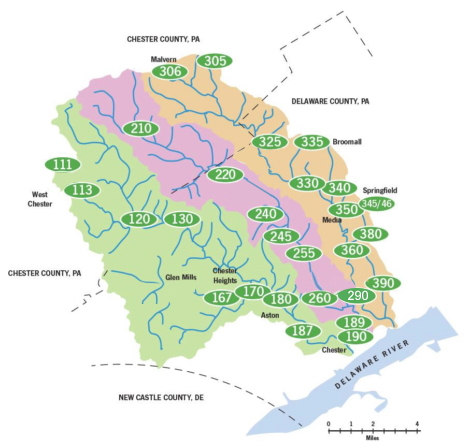About CRC

Chester Ridley Crum Watersheds Association (CRC) is a nonprofit 501(c)(3) organization devoted to the protection of water resources and the natural environment of the Chester, Ridley, and Crum Creek Valleys, and the health, recreational, and quality of life benefits they afford the residents of this region.
Our stewardship area encompasses 132 square miles and 40 municipalities, from the South Valley Hills to the Delaware River.
Mission & Vision
CRC Watersheds Association’s mission is to support, encourage and promote the enjoyment, restoration, conservation, protection and prudent management of the natural resources of the Chester, Ridley, and Crum Creek Watersheds.
History of CRC
CRC was established as a 501(c)(3), non-profit corporation in 1970, nearly 50 years ago, by a group of local citizens concerned about the impacts of increasing urban and suburban development on the three watersheds in the area – namely the Chester, Ridley, and Crum Creek watersheds – including the main stems of these creeks and their tributaries. Although concerns related to development impacts on area water quality was at the forefront of their minds, the ongoing construction of the Blue Route was the tipping point, motivating action and organization, as individuals and entities fought to counter the proposed location and mitigate the impacts of the highway.
Through its early years, and into the late 1980s, CRC, which was an all-volunteer organization, leveraged the interests and energy of its Board and membership to comment upon and influence the permitting and construction of the Blue Route, until March 24, 1986, when the Blue Route’s path to completion was cleared by the Supreme Court of the United States, which upheld a Third U.S. Circuit Court of Appeals’ decision to allow construction to proceed.
CRC took on new energy in the mid-1990s, when Board leadership initiated watershed wide cleanups in April, which continue today. These cleanups leverage CRC’s strong relationships with area municipalities and townships, coordinating trash and debris removal from area streams with public works collection and disposal of garbage accumulated by volunteers.
CRC decided to expand its efforts to fulfill its mission around the turn of the century, by hiring staff to pursue funding and execute programs. Since that time, CRC has established a rigorous and productive tree planting program, an Annual Awards Dinner recognizing outstanding community service, a water quality monitoring program, and a speaker’s forum in part in support of our municipal partners and their stormwater permitting needs. All of these changes point to CRC responding to the community that desires “shovel and rake” programs that improve watershed health addressing stream impairment and improving the source of our drinking water.
The future is bright for CRC, as we move into our fifth decade, as stream and riparian corridor restoration and enhancements will be addressed directly by our programs including tree plantings, invasives management, and the implementation of best management practices for sediment and nutrient control. We also see an important role of CRC’s water quality monitoring in the future which will help characterize and verify the impacts of local resource investment on sediment control and management. Finally, CRC will continue to expand and enhance its volunteer coordination and programs, to increase community capacity to support healthy watersheds and life styles in the years and decades to come.
CRC Watersheds Association headquarters are located at Willistown Township's Okehocking Preserve farmhouse.
